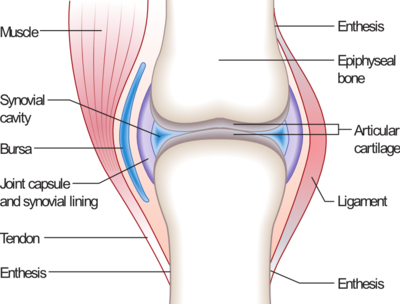- Synovial joint
-
A Synovial joint, also known as a diarthrosis, is the most common and most movable type of joint in the body of a mammal. As with most other joints, synovial joints achieve movement at the point of contact of the articulating bones.
Structural and functional differences distinguish synovial joints from cartilaginous joints (synchondroses and symphyses) and fibrous joints (Sutures, gomphoses, and syndesmoses). The main structural differences between synovial and fibrous joints are the existence of capsules surrounding the articulating surfaces of a synovial joint and the presence of lubricating synovial fluid within those capsules (synovial cavities).
Contents
Structure
Synovial joints contain the following structures:
- Synovial cavity: all diarthroses have this characteristic space between the bones that is filled with synovial fluid
- Articular capsule: the fibrous capsule, continuous with the periosteum of articulating bones, surrounds the diarthrosis and unites the articulating bones; the articular capsule consists of two layers - (1) the outer fibrous membrane that may contain ligaments and (2) the inner synovial membrane that secretes the lubricating, shock absorbing, and joint-nourishing synovial fluid; the articular capsule is highly innervated, but avascular (lacking blood and lymph vessels), and receives nutrition from the surrounding blood supply via either diffusion (a slow process) or by convection, a far more efficient process achieved through exercise
- Articular cartilage: the bones of a synovial joint are covered by this layer of hyaline cartilage that lines the epiphyses of joint end of bone with a smooth, slippery surface that does not bind them together; articular cartilage functions to absorb shock and reduce friction during movement
Many diarthroses also contain:
- Articular discs or menisci - the fibrocartilage pads between opposing surfaces in a joint
- Articular fat pads - adipose tissue pads that protect the articular cartilage, as seen in the infrapatellar fat pad in the knee
- Accessory ligaments (extracapsular and intracapsular) - the fibers of some fibrous membranes are arranged in parallel bundles of dense regular connective tissue that are highly adapted for resisting strains to prevent extreme movements that may damage the articulation
- Tendons - cords of dense regular connective tissue composed of parallel bundles of collagen fibers
- Bursae - saclike structures that are situated strategically to alleviate friction in some joints (shoulder and knee) that are filled with fluid that is similar to synovial fluid [1]
The bone surrounding the joint on the proximal side is sometimes called the plafond, especially in the talocrural joint. A damage to this occurs in a Gosselin fracture.
Blood supply
The blood supply of a synovial joint is derived from the arteries sharing in the anastomosis around the joint.
Movements possible
The movements possible with synovial joints are:
- Abduction: movement away from the mid-line of the body
- Adduction: movement toward the mid-line of the body
- Extension: straightening limbs at a joint
- Flexion: bending the limbs at a joint
- Rotation: a circular movement around a fixed point
Types
There are seven types of synovial joints. Some are relatively immobile, but are more stable. Others have multiple degrees of freedom, but at the expense of greater risk of injury. In ascending order of mobility, they are:[2]
Name Example Description Gliding joints (or planar joints) the carpals of the wrist, acromioclavicular joint These joints allow only gliding or sliding movements Hinge joints the elbow (between the humerus and the ulna) These joints act as a door hinge does, allowing flexion and extension in just one plane Pivot joints Atlanto-axial joint, proximal radioulnar joint, and distal radioulnar joint One bone rotates about another Condyloid joints (or ellipsoidal joints) the wrist joint (radiocarpal joint) temporomandibular joint A condyloid joint is where two bones fit together with an odd shape (e.g. an ellipse), and one bone is concave, the other convex; some classifications make a distinction between condyloid and ellipsoid joints; these joints allow flexion, extension, abduction, and adduction movements (circumduction). Saddle joints Carpometacarpal or Trapeziometacarpal Joint of thumb (between the metacarpal and carpal - the trapezium), sternoclavicular joint Saddle joints, which resemble a saddle, permit the same movements as the condyloid joints Ball and socket joints "Universal Joint"
the shoulder (glenohumeral), and hip joints These allow for all movements except gliding Compound joints the knee joint condylar joint (condyles of femur join with condyles of tibia) and saddle joint (lower end of femur joins with patella) Factors influencing joint stability
- The shape of articular surfaces
- Capsule and ligaments
- Muscle Tone
- Gravity
- Atmospheric Pressure
References
- ^ Principles of Anatomy & Physiology, 12th Edition, Tortora & Derrickson, Pub: Wiley & Sons
- ^ Module - Introduction to Joints
Joints (TA A03.0, TH H3.02, GA 3.284) Types fibrous: Gomphosis · Suture · Syndesmosis · Interosseous membrane
cartilaginous: Synchondrosis · Symphysis
synovial: Plane joint · 1° (Hinge joint, Pivot joint) · 2° (Condyloid joint, Saddle joint) · 3° (Ball and socket joint)
by range of motion: Synarthrosis · Amphiarthrosis · DiarthrosisTerminology Motions general: Flexion/Extension · Adduction/Abduction · Internal rotation/External rotation · Elevation/Depression
specialized/upper limbs: Protraction/Retraction · Supination/Pronation
specialized/lower limbs: Plantarflexion/Dorsiflexion · Eversion/InversionComponents capsular: Articular capsule (Synovial membrane, Fibrous membrane) · Synovial fluid · Synovial bursa · Articular disk/Meniscus
extracapsular: Ligament · EnthesisM: JNT
anat(h/c, u, t, l)/phys
noco(arth/defr/back/soft)/cong, sysi/epon, injr
proc, drug(M01C, M4)
Categories:- Joints
- Musculoskeletal system stubs
Wikimedia Foundation. 2010.

